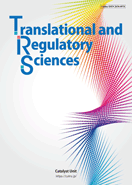Volume 4, Issue 2
Displaying 1-5 of 5 articles from this issue
- |<
- <
- 1
- >
- >|
RS
-
2022Volume 4Issue 2 Pages 30-36
Published: 2022
Released on J-STAGE: June 25, 2022
Download PDF (824K) Full view HTML
Immunology/Allergy
-
2022Volume 4Issue 2 Pages 37-39
Published: 2022
Released on J-STAGE: July 20, 2022
Download PDF (849K) Full view HTML
TRS
-
2022Volume 4Issue 2 Pages 40-44
Published: 2022
Released on J-STAGE: August 02, 2022
Download PDF (1603K) Full view HTML
TS
-
2022Volume 4Issue 2 Pages 45-47
Published: 2022
Released on J-STAGE: August 05, 2022
Download PDF (865K) Full view HTML
Biochemistry
-
2022Volume 4Issue 2 Pages 48-52
Published: 2022
Released on J-STAGE: August 05, 2022
Advance online publication: July 27, 2022Download PDF (2828K) Full view HTML
- |<
- <
- 1
- >
- >|
